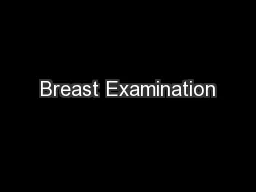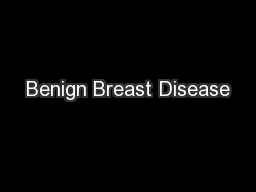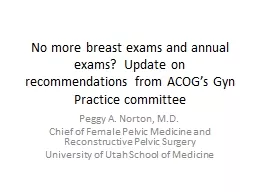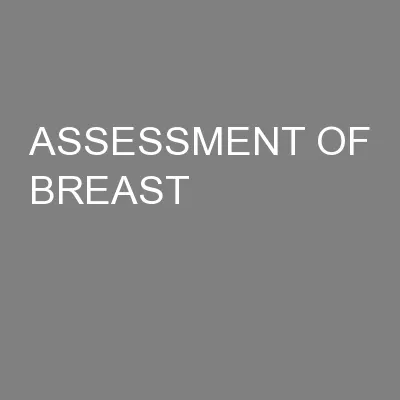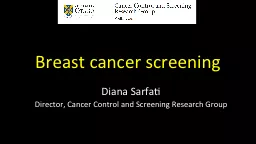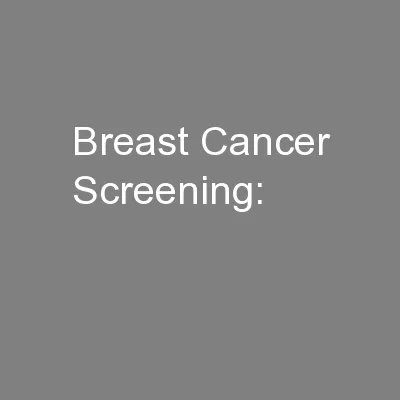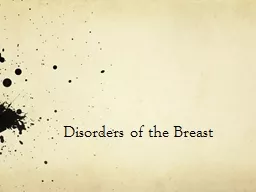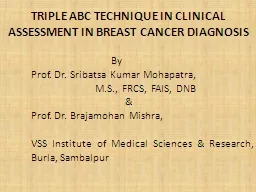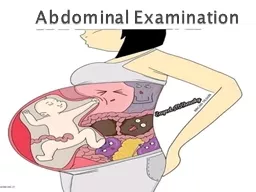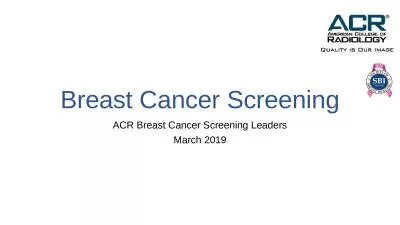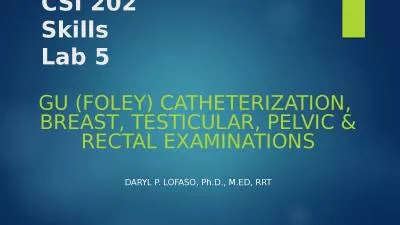PPT-Breast Examination
Author : yoshiko-marsland | Published Date : 2015-09-23
Robert Collins GPVTS1 Topics Breast history Examination Investigations Breast conditions Benign Malignant Treatment History Presenting complaint is v important
Presentation Embed Code
Download Presentation
Download Presentation The PPT/PDF document "Breast Examination" is the property of its rightful owner. Permission is granted to download and print the materials on this website for personal, non-commercial use only, and to display it on your personal computer provided you do not modify the materials and that you retain all copyright notices contained in the materials. By downloading content from our website, you accept the terms of this agreement.
Breast Examination: Transcript
Robert Collins GPVTS1 Topics Breast history Examination Investigations Breast conditions Benign Malignant Treatment History Presenting complaint is v important Lump always ask how long been present. nbcamorg reast cancer is the second most common kind of cancer in women About 1 in 8 women born today in the United States will get breast cancer at some point The good news is that many women can survive breast cancer if its found and treated earl Questions. What are the treatments for cyclical . mastalgia. ?. What is the . DDx. of nipple discharge? How should this be managed?. What are . phylloides. . tumours. of the breast and how are they managed?. G. yn. . P. ractice . committee. Peggy A. Norton, M.D.. Chief of Female Pelvic Medicine and Reconstructive Pelvic Surgery. University of Utah School of Medicine. Learning Objectives. Describe the source of committee opinions and practice bulletins in ACOG. SYMPTOMS/LUMPS. Professor P Grantley Gill. Specialists Without Borders. Seminar in Surgery . Rwanda, September 2010. SIGNS AND SYMPTOMS AT PRESENTATION. Palpable mass. Thickening, Pain. . Mass or pain in the axilla. DR. A. AKHATOR FWACS, FICS. SENIOR LECTURER DELSU . CONSULTANT SURGEON DELSUTH. PRE-TEST. Breast cancer is the most common cancer in women in Nigeria . Breast cancer is the most common cause of cancer related deaths. Diana Sarfati. Director, Cancer Control and Screening Research Group. Breast cancer. Most common cancer for women in NZ . 600 women die each year from breast cancer. Trends . in age standardized I. ncidence . Changing Philosophies in Educating Women and Teens . Courtney Benedict CNM MSN. Disclosures. Merck Nexplanon trainer . Session Objectives. Explain the rationale for initiation and frequency of clinical breast exams to clients. The Obstetrics & Gynecological Society of Bhopal. &. AMPOGS . Research Public Welfare Society. Screening tools. Clinical Breast examination. Breast self examination. Mammography. Ultrasonography/. Inspection. Size. S. ymmetry (some variation is normal) . Shape. Contour (flattening, masses, and dimpling). S. kin (color, edema, rashes, thickening, and venous pattern). S. cars (previous surgery, injuries). By . Prof. Dr. . Sribatsa. Kumar . Mohapatra. , . M.S., FRCS, FAIS, DNB . & . Prof. Dr. . Brajamohan. . Mishra. , . . VSS Institute of Medical Sciences & Research, . . Definition:. -. It is a visual, tactile and or audible examination of the woman's abdomen.. . 1. To confirm . pregnancy.. 2. To assess fetal size and . growth.. 3. To identify the location of fetal . relievers (Excedrin, Midol), diuretics (AquaBan)and weight control aids (Dietac, Promamine).HerbalsGuarana and kola nut (both strong sources of caffeine); Ma Huang, ephedra sinica, Chinese ephedra (so March 2019. Preview/Introduction. The Risk of Breast Cancer to Women. Does Mammography Save Lives?. When to Start and How Often Should Women Screen?. Risks Versus Benefits of Mammography. Breast Cancer: The Impact on Women. Daryl P. Lofaso, P. h. .D., . M.Ed. , RRT. Urethral Catheterization. Indications. Long Term. Refractory bladder outlet obstruction. Neurogenic bladder with urinary retention. Complications of incontinence.
Download Document
Here is the link to download the presentation.
"Breast Examination"The content belongs to its owner. You may download and print it for personal use, without modification, and keep all copyright notices. By downloading, you agree to these terms.
Related Documents

